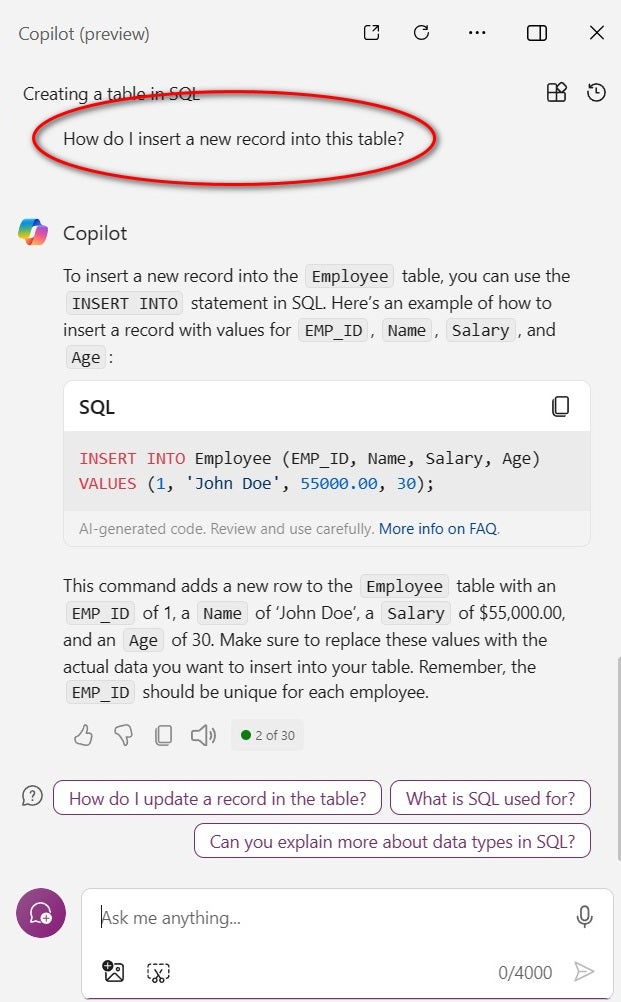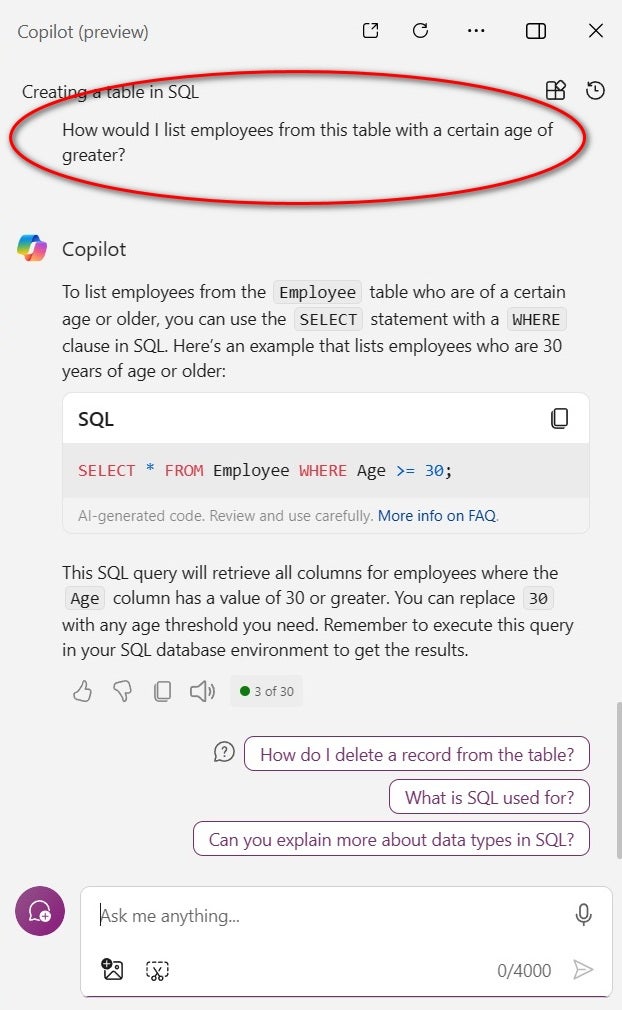
 technology
technology 
According to the claims made by large technology companies, generative artificial intelligence platforms like Microsoft Copilot will make the working lives of people at all levels of a business organization more productive and efficient. But is that just hyperbole, or do the claims have some merit?
For example, can the free version of Microsoft Copilot, available to all Windows users, write a common SQL query for you on command? That ability would be extremely useful for a time-constrained, less-experienced employee trying to meet a deadline. Below, we explore what happens when we ask Microsoft Copilot for some SQL help.
DOWNLOAD: AI quick glossary from TechRepublic Premium
For our experiment, we started with something basic and simple. Using Creative mode, we asked Microsoft Copilot for the code required to create a table in SQL named Employee that included four columns: EMP_ID, Name, Salary, Age. The AI provided this code:CREATE TABLE Employee (
EMP_ID INT PRIMARY KEY,
Name VARCHAR(100),
Salary DECIMAL(10, 2),
Age INT
);
You can see the prompt and code in Figure A.
While this code would likely require tweaking depending on your specific needs, in general, the code was accurate and useful based on what was asked of Copilot.
Note the explanation provided by Microsoft Copilot as well; it is as important as the code:
“This statement defines EMP_ID as an integer and the primary key for the table, Name as a variable character string with a maximum length of 100 characters, Salary as a decimal with 10 digits in total and 2 digits after the decimal point, and Age as an integer. Adjust the data types and sizes according to your specific requirements.”
Continuing our session with Microsoft Copilot, we then asked the AI to generate the code necessary to insert a new record into this table. The resulting code is below:
INSERT INTO Employee (EMP_ID, Name, Salary, Age) VALUES (1, 'John Doe', 55000.00, 30);
You can see the prompt and code in Figure B.

The VALUES section would need to be modified for your specific needs, but the code and the explanation provided by Copilot were accurate and useful. It’s important to note that once our table of employees is complete, we may be tasked with writing queries to pull data from our database.
Next in our session with Microsoft Copilot, we asked the AI to generate the code necessary to list employees from this table with a certain age or greater. In this case, Microsoft Copilot suggested this code.
SELECT * FROM Employee WHERE Age >= 30;
You can see the prompt and code in Figure C.

Again, while you may need to adjust the code for your specific needs, this code was accurate and useful for employees less familiar with SQL syntax.
So, when asked the right way, Microsoft Copilot can write basic SQL code for your employees. However, whatever answers are generated by Copilot should always be scrutinized for applicability and accuracy.
DOWNLOAD: AI vs machine learning differences and use cases from TechRepublic Premium
We can draw these conclusions from our experiment with Microsoft Copilot:
We have proven that Microsoft Copilot can be a useful productivity tool for your employees, but only if it is used correctly. Employees must realize that Copilot, and any other generative AI platform, is not just another search engine. Questions submitted to Copilot must be thought out, detailed and specific. The more detailed the question, the more detailed the answer. Employees must also realize that the first question is often just the foundation that leads to a more useful and enlightening conversation with Copilot.
24World Media does not take any responsibility of the information you see on this page. The content this page contains is from independent third-party content provider. If you have any concerns regarding the content, please free to write us here: contact@24worldmedia.com